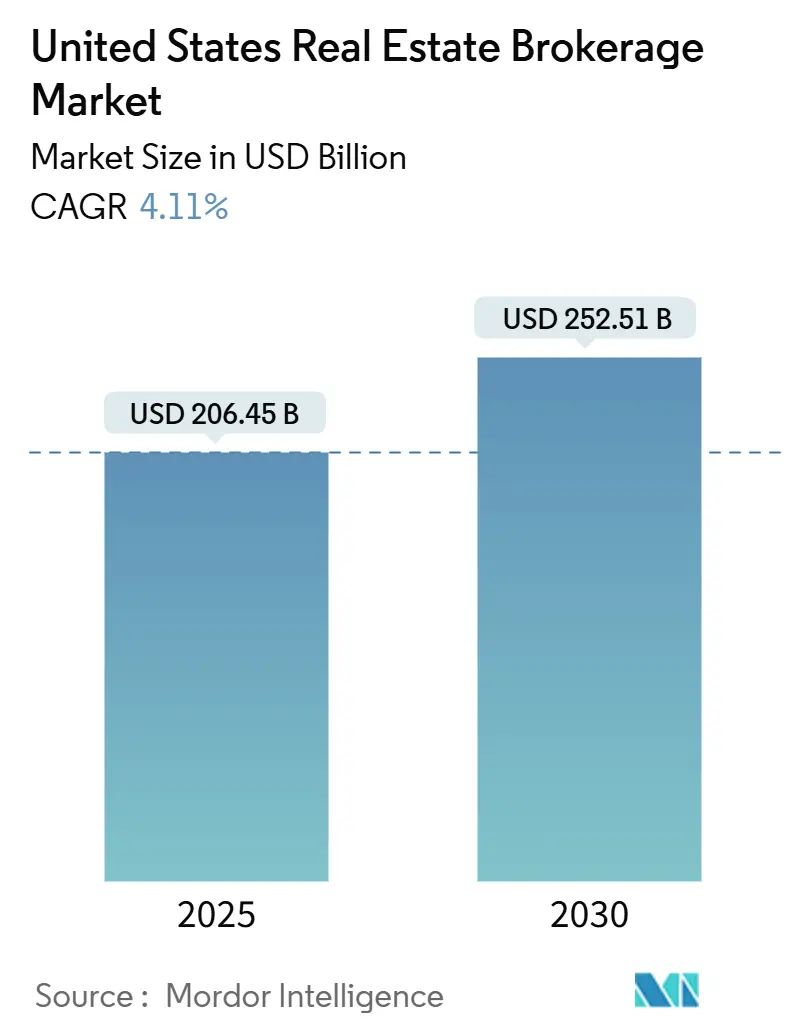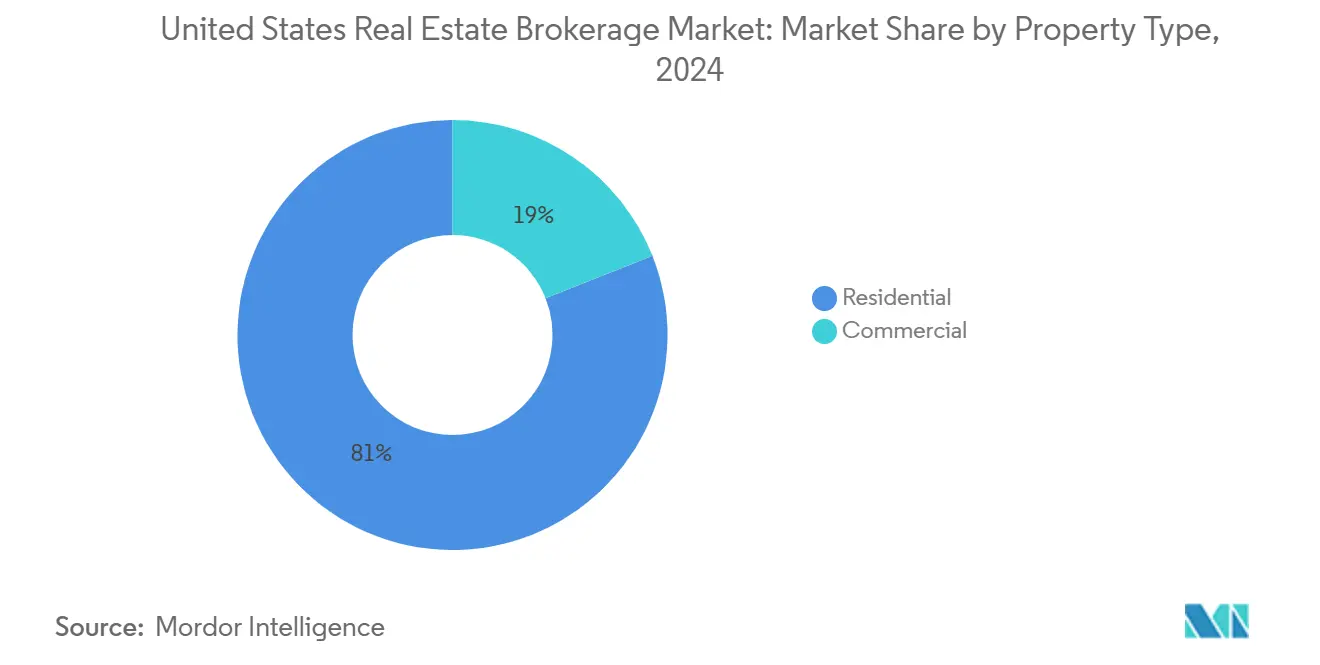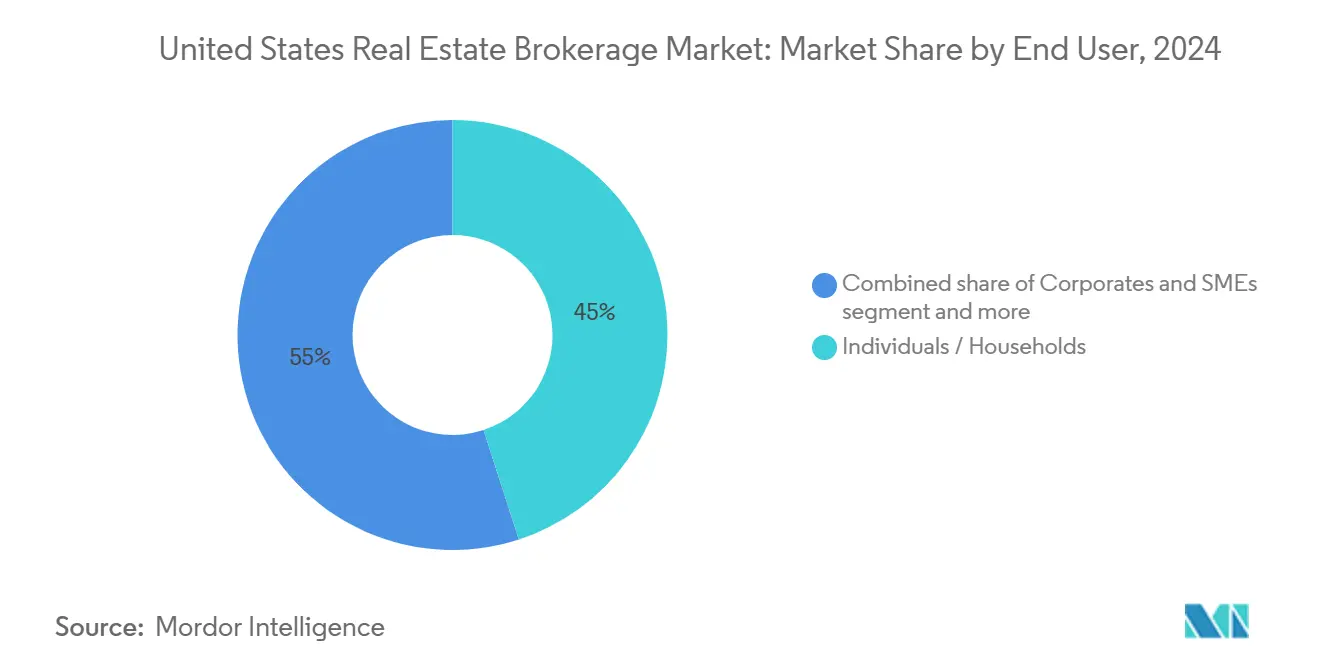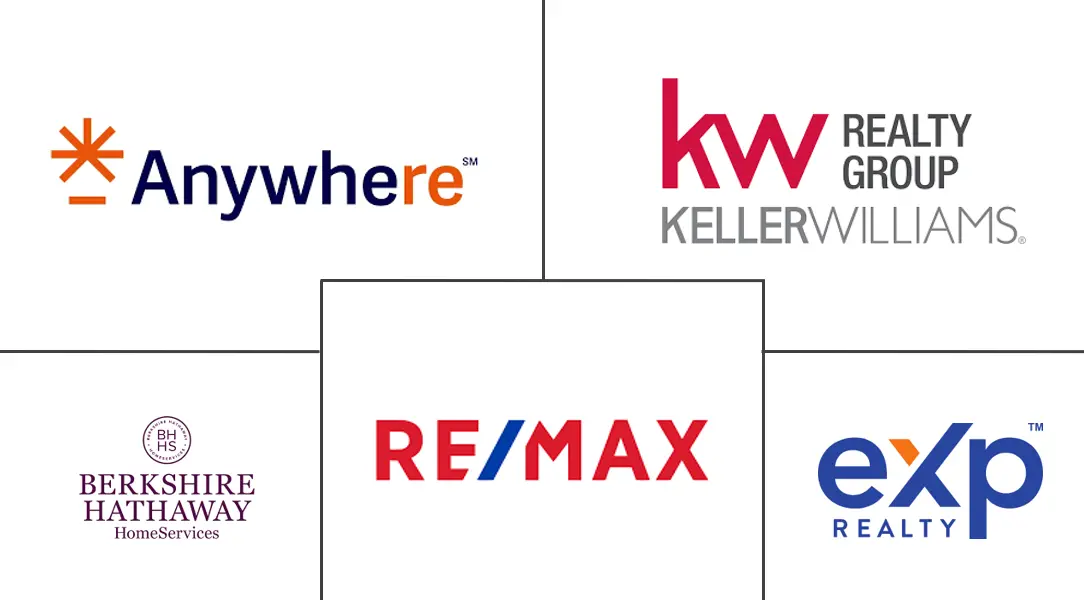United States Real Estate Brokerage Market Size and Share

United States Real Estate Brokerage Market Analysis by Mordor Intelligence
United States real estate brokerage market stands at USD 206.45 billion in 2025 and is set to rise to USD 252.51 billion by 2030, reflecting a resilient 4.11% CAGR. Momentum stems from demographic tailwinds, the rebound in housing inventory, and a rapid shift toward digital client-acquisition models. Heightened Department of Justice (DOJ) scrutiny of buyer-agent commissions has already re-shaped compensation structures, yet the market continues to expand as brokerages diversify into mortgage, title, and rental-management income streams. Consolidation is accelerating, with firms such as Rocket Companies moving to acquire Redfin and Compass purchasing @properties and Christie’s International Real Estate, demonstrating the strategic impulse to build vertically integrated platforms that protect margin in the evolving regulatory environment. Regionally, the Southeast retains outsized influence while the Southwest posts the fastest growth, and institutional single-family rental (SFR) demand supports consistent deal flow across sun-belt metros even as mortgage-rate volatility tempers overall transaction velocity.
Key Report Takeaways
- By property type, residential real estate held 81% of the United States real estate brokerage market share in 2024; logistics/industrial is projected to expand at a 4.27% CAGR to 2030.
- By services, sales commanded 64% of the United States real estate brokerage market share in 2024, while rental/leasing is projected to expand at a 4.69% CAGR through 2030.
- By end-use, individuals and households accounted for 45% of the United States real estate brokerage market size in 2024, while corporates & SMEs show the quickest climb at 4.52% between 2025-2030.
- By state, Texas led with 10.2% of the United States real estate brokerage market share in 2024; Illinois is forecast to advance at a 4.34% CAGR through 2030.
United States Real Estate Brokerage Market Trends and Insights
Drivers Impact Analysis
| Driver | (~) % Impact on CAGR Forecast | Geographic Relevance | Impact Timeline |
|---|---|---|---|
| Convergence with mortgage & title for full-stack revenue | +0.9% | National, with early adoption in competitive metros | Medium term (2-4 years) |
| Rising housing demand & household formation | +0.8% | National, with concentration in Southwest and Southeast | Medium term (2-4 years) |
| Digital lead-generation and CRM adoption | +0.6% | National, with early gains in tech-forward markets | Short term (≤ 2 years) |
| Recovery in housing inventory & new-build pipeline | +0.7% | National, particularly in supply-constrained metros | Medium term (2-4 years) |
| Expansion of cloud-based, low-overhead brokerage models | +0.5% | National, with higher penetration in cost-sensitive markets | Long term (≥ 4 years) |
| Institutional SFR growth sustaining deal flow | +0.4% | Concentrated in Sun Belt and emerging secondary markets | Long term (≥ 4 years) |
| Source: Mordor Intelligence | |||
Rising Housing Demand & Household Formation
Millennials entering peak family-formation years are driving a steady influx of first-time buyers, even as affordability remains tight. National Association of Home Builders data show annual housing demand topping 1.15 million units, sustaining an elevated baseline for brokerage transactions[1]Robert Dietz, “Housing Shortage and Household Formation,” National Association of Home Builders, nahb.org. Builder incentives and remote-work flexibility are boosting new-home sales to more than 30% of overall deals, preserving commission stability for agents who specialize in new construction. Because 43% of buyers no longer prioritize job location, brokerages can match clients with a broader geographic inventory, thereby amplifying market reach. Taken together, these dynamics underpin a durable revenue foundation for the US real estate brokerage market.
Digital Lead-Generation and CRM Adoption
Social media is now the top lead channel for 54% of agents, while advanced CRM platforms nurture longer buyer journeys necessitated by tighter credit standards. Industry surveys reveal that 79% of professionals find e-signature tools highly impactful and that cloud-storage penetration has climbed to 48%. PropTech funding in 2024 steered 4% of capital toward agent-facing AI products that score leads and automate follow-ups, letting brokerages drive productivity gains and differentiate on service in the US real estate brokerage market.
Recovery in Housing Inventory & New-Build Pipeline
Inventory recovery is uneven but material: new-home starts expanded 4.7% in 2024, boosting available listings in inland metros and some southern suburbs. Current inventory sits at 4.4 months of supply, short of the 5-6 month balance point, preserving pricing power. Townhomes now approach 20% of starts, adding a mid-density option prized by younger households. Builders increasingly rely on real estate agents to manage longer construction timelines, channeling steady deal volume into the US real estate brokerage market even when resale listings remain scarce.
Convergence with Mortgage & Title for Full-Stack Revenue
Vertical integration is gaining urgency. Rocket Companies’ USD 1.75 billion Redfin acquisition combined mortgage origination, brokerage, and technology into a single ecosystem, signaling a pivot toward end-to-end transaction control. Compass folded Proper Title and Proper Rate into its @properties purchase, creating fresh cross-sell avenues that help offset downward commission pressure. If the Federal Housing Finance Agency green-lights buyer-agent fees within mortgages, these integrated models could extract new margin pools, further accelerating revenue diversification across the US real estate brokerage market.
Restraints Impact Analysis
| Restraint | (~) % Impact on CAGR Forecast | Geographic Relevance | Impact Timeline |
|---|---|---|---|
| Mortgage-rate volatility dampening transactions | -0.9% | National, with higher impact in rate-sensitive markets | Short term (≤ 2 years) |
| DOJ scrutiny of buyer-agent commissions | -0.7% | National, with immediate implementation effects | Medium term (2-4 years) |
| Sun-Belt migration creating legacy-market overcapacity | -0.3% | Concentrated in traditional destination markets | Long term (≥ 4 years) |
| AI self-service listing tools shrinking fee pool | -0.4% | National, with faster adoption in tech-forward markets | Long term (≥ 4 years) |
| Source: Mordor Intelligence | |||
Mortgage-Rate Volatility Dampening Transactions
Persistently higher mortgage rates—hovering in the 6-7% band—continue to limit affordability, particularly for entry-level buyers. The Mortgage Bankers Association projects purchase originations rising just 13% to USD 1.46 trillion in 2025, well below historic volume peaks. California underscores the strain: only 14% of households could afford the median home in Q2 2024, crimping churn in a pivotal market. With refinancing still suppressed at 22% of originations, integrated broker-lender platforms must lean on premium listings to uphold revenue amid fewer overall closings in the US real estate brokerage market.
DOJ Scrutiny of Buyer-Agent Commissions
The DOJ’s continuing probe into National Association of Realtors policies culminated in August 2024 rule changes that require buyers to sign commission agreements before touring homes, injecting real-time price competition into agent fees. Keller Williams has already paid a USD 70 million settlement, and regulators signaled larger demands by rejecting a USD 4 million proposal in a separate case. These shifts accelerate the adoption of fee-for-service or flat-fee models, pressuring traditional percentage-based income streams across the US real estate brokerage market even as consumer transparency improves.
Segment Analysis
By Property Type: Residential Dominance Anchors Revenue Growth
The residential segment accounted for an 81% US real estate brokerage market share in 2024, confirming its status as the industry growth anchor. Detached villas and landed houses formed 63% of that total, as suburban preferences established during the pandemic persisted and as family-formation rates climbed. Apartments and condominiums, however, are set to advance the fastest at a 4.48% CAGR to 2030, propelled by dense-core affordability and revived downtown amenities. In this context, the US real estate brokerage market size for multifamily listings is expected to appreciate meaningfully as institutional investors compete with individual buyers.
Residential resilience is bolstered by builders courting rate-sensitive buyers with mortgage buydowns and closing-cost credits. Brokerage firms that cultivate builder partnerships enjoy steadier commission flow because new-construction deals now exceed 30% of total sales. Technology deepens the moat: 96% of agents rely on smartphones and 91% on desktop tools, letting them compress cycle times and manage paperwork digitally. Conversely, commercial brokerage remains a margin-expansion lever, especially in logistics/industrial, where a 4.27% CAGR reflects e-commerce supply-chain redesign. That dynamism offers diversified firms hedges against single-sector slowdowns, but strong residential traction keeps them rooted in the core of the US real estate brokerage market.

By End-User: Consumer Core, Institutional Upside
Individuals/households mirrored the client-type breakdown with a 45% stake in 2024, reflecting the classic owner-occupier focus of brokerage services. Despite stretched affordability, households view real estate as the primary pathway to wealth accumulation, so demand remains inelastic relative to other asset classes. For brokerages, consumer trust stems from a blend of localized expertise and seamless tech, such as e-signature capabilities that 79% of professionals praise for expediting closings.
Corporates & SMEs occupy the fast-growth lane at a 4.52% CAGR, echoing rising institutional appetite for both operational and investment real estate. Rocket Companies’ move to fuse mortgage and brokerage arms shows how end-users increasingly want bundled solutions that compress timelines and lower friction. In parallel, SFR funds lean on brokerages not only for acquisition but also for bulk disposition and build-to-rent pipeline sourcing, expanding revenue per client. The remaining Other end-user pool—government, nonprofit, and special-purpose entities—demands compliance rigor and custom workflows, providing another specialty niche. Together these dynamics deepen segmentation complexity and solidify the US real estate brokerage market as a multi-track growth arena.

By Services: Sales Brokerage Dominates, Rental Activity Scales Faster
Sales transactions captured a 64% US real estate brokerage market share in 2024, underscoring their historic role as the primary revenue engine for full-service firms. Purchase deals remain the cornerstone of agent income because consumer demand for ownership continues to track demographic formation and wealth-building goals, even in a higher-rate environment. Digital contract tools streamline closings and help sales agents handle wider geographic territories, supporting volume without proportional cost increases. Integrations with mortgage and title lines further lock in margin on each purchase, keeping the US real estate brokerage market size for sales services firmly ahead of other categories.
Rental and leasing services, although smaller in absolute terms, are forecast to post a 4.69% CAGR through 2030, outpacing every other service line. Affordability constraints push more households toward long-term renting, while institutional single-family rental funds expand portfolios in secondary metros, lifting leasing commission opportunities. Corporate relocations also boost demand for short-term and build-to-rent contracts, requiring brokerages to develop specialized tenant-placement and property-management capabilities. Because rentals generate recurring fees and steady client touchpoints, firms view the segment as a hedge against cyclical sales downturns and a pathway to cross-sell maintenance or valuation services. Together, the dual-track growth of sales and rentals strengthens the cash-flow resilience of the broader US real estate brokerage market.
Geography Analysis
Texas commanded 10.2% of the United States real estate brokerage market share in 2024, making it the single-largest state segment. Rapid in-migration, business-relocation pipelines, and an expanding new-construction base underpin a deal environment that remains robust even as mortgage rates stay elevated. Major metros such as Dallas, Houston, and Austin continue to draw both tech and energy employers, which sustains residential turnover and feeds demand for industrial sites positioned along the I-35 and I-45 corridors. Builder incentives—including rate buydowns and closing-cost credits—keep first-time homebuyer pipelines alive, while institutional SFR funds steadily acquire build-to-rent projects around San Antonio and suburban Dallas. Brokerage firms with integrated mortgage desks are leveraging these dynamics to close transactions faster, winning share in a competitive agent market where digital lead-capture tactics dominate.
California trails Texas in 2024 share but remains a critical revenue center, especially in luxury and cross-border investment niches. Persistent affordability challenges—only 14% of households could purchase the median-priced home—continue to depress volume in entry-level brackets, yet systemic undersupply keeps price points elevated. Florida capitalizes on out-of-state inflows from the Northeast and Midwest, but net migration into Tampa slowed to just over 10,000 residents as relative housing costs rose. New York and the Rest of US segments illustrate the push-pull of remote-work dispersion; while Manhattan condo turnover lags its pre-pandemic highs, upstate New York sees a modest uplift in suburban and second-home deals. Brokerages balance the high-value coastal closings that still command premium fees against the steadier Midwestern and Southern transactions that build annuity-style pipeline.
Illinois is set to be the fastest-growing state market, with the segment expected to expand at a 4.34% CAGR through 2030. Chicago’s diversified economy—anchored by health care, logistics, and financial services—has attracted a fresh wave of corporate relocations from higher-cost coastal metros. Suburban infill projects and adaptive-reuse developments in the West Loop and Fulton Market are creating pockets of rapid brokerage activity, while institutional investors eye Class B multifamily assets for yield. Florida’s Panhandle and Texas’ secondary metros similarly pull spillover demand from overheated urban cores, illustrating how affordability gradients drive state-level churn. Across all six states, brokerages that combine hyper-local expertise with scalable tech platforms are best positioned to navigate divergent growth paths and capitalize on shifting migration currents within the US real estate brokerage market.
Competitive Landscape
The US real estate brokerage market competition continues to tighten as regulatory shifts, technology adoption, and capital inflows reshape strategic priorities. National franchise systems—Anywhere Real Estate, Keller Williams, and RE/MAX—maintain reach through extensive agent networks, but disruptors such as eXp Realty employ cloud-based infrastructures to grant agents higher splits with lower overhead. Meanwhile, Compass has blended premium branding with proprietary CRM tools to court top producers, raising its profile through selective acquisitions.
Vertical integration marks the newest competitive frontier. Rocket Companies’ USD 1.75 billion Redfin acquisition pairs a vast mortgage origination engine with a tech-centric brokerage, offering consumers a one-stop pathway from search to closing. Compass’s USD 444 million deal for @properties and Christie’s International Real Estate follows a similar arc, adding title and mortgage units that unlock incremental revenue per transaction. Such moves seek to defend margins as the DOJ fosters commission-rate transparency and fee pressure across the broader US real estate brokerage market.
Technology remains a decisive leveling force. Nearly four out of five agents identify e-signature tools as essential, while AI-driven pricing engines and blockchain-based contract ledgers transition from experimentation to early deployment. Firms that successfully marry these tools with human insight can differentiate on speed, accuracy, and convenience. Talent retention is likewise critical: Redfin’s “Redfin Next” plan now offers agent splits up to 75%, signaling a market in which brokerage value propositions must extend beyond brand to include career economics. Although the top twenty brokers increased combined share modestly in 2024, more than 86% of total transactions still flow through thousands of small and midsized outfits, underscoring the continued fragmentation of the US real estate brokerage market.
United States Real Estate Brokerage Industry Leaders
-
Anywhere Real Estate (Coldwell Banker, Century 21, ERA, etc.)
-
Keller Williams Realty
-
RE/MAX
-
Berkshire Hathaway HomeServices
-
eXp Realty
- *Disclaimer: Major Players sorted in no particular order

Recent Industry Developments
- March 2025: Rocket Companies agreed to acquire Redfin for USD 1.75 billion, aiming to build an integrated search-to-close platform.
- January 2025: Maymont Homes, a Brookfield Properties unit, purchased rent-to-own operator Divvy Homes, boosting its portfolio to 14,884 rentals.
- December 2024: Compass finalized its USD 444 million purchase of @properties and Christie’s International Real Estate, adding mortgage and title operations.
- November 2024: National Association of REALTORS® reported median agent income fell to USD 55,800 amid tight inventory and affordability headwinds.
United States Real Estate Brokerage Market Report Scope
Real estate brokerage involves various activities, including dealing in timeshares, selling, buying, negotiating real estate transactions, property management, leasing, renting, and referring prospects to secure real estate or its improvements, all in exchange for a fee or compensation.
The US real estate brokerage market is segmented by type (residential and non-residential) and service (sales and rental). The report offers market size and forecasts in value (USD) for all the above segments.
| Residential | Apartments and Condominums |
| Villas and Landed Houses | |
| Commercial | Office |
| Retail | |
| Logistics | |
| Others |
| Sales |
| Rental / Leasing |
| Individuals / Households |
| Corporates & SMEs |
| Others |
| Texas |
| California |
| Florida |
| New York |
| Illinois |
| Rest of US |
| By Property Type | Residential | Apartments and Condominums |
| Villas and Landed Houses | ||
| Commercial | Office | |
| Retail | ||
| Logistics | ||
| Others | ||
| By Service | Sales | |
| Rental / Leasing | ||
| By End-user | Individuals / Households | |
| Corporates & SMEs | ||
| Others | ||
| By State | Texas | |
| California | ||
| Florida | ||
| New York | ||
| Illinois | ||
| Rest of US | ||
Key Questions Answered in the Report
What is the current size of the US real estate brokerage market?
The market is valued at USD 206.45 billion in 2025 and is forecast to reach USD 252.51 billion by 2030.
How fast is the US real estate brokerage market growing?
It is expanding at a 4.11% CAGR through 2030, supported by demographic demand and technology adoption.
Which region is growing the quickest?
The Southwest leads with a projected 4.34% CAGR, driven by corporate relocations and new-construction activity.
How are commission structures changing?
New DOJ-driven rules now require buyer-agent contracts before showings, increasing transparency and putting downward pressure on traditional percentage-based fees.
Why are brokerages pursuing vertical integration?
Combining brokerage, mortgage, and title services helps firms capture additional revenue streams and protect margins amid commission compression.
What technologies are most impactful today?
Agents cite e-signature platforms, AI-powered lead-scoring, and cloud-based transaction management as the tools that most improve efficiency and client experience.
Page last updated on:



